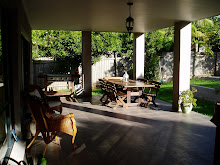Someone asked me recently what universal design is.
If I were impatient and direct and - you know - Australian - I would say "It's the bloody way all buildings, houses, apartments, transport, recreation areas etc should be designed". Of course, I am getting old and have learnt the hard way the necessity and art of politesse.
And ok, it's a fair question. So ...
Universal design principles have been around since the 1970s, originating at the Center for Accessible Housing at North Carolina State University
As the name implies, universal design (UD) homes (or UD education systems - stay tuned) are accessible to the widest number of people irrespective of their abilities.
You can have an entry like this >>>
Which many people can’t enter.
Or apply UD rule # 1 – barrier-free entry.
NO STEPS. Think ramps or paths.
NO STEPS. Think ramps or paths.
In fact, just think. Do you need steps? A no-step entry allows you to actually get in the door of your home if you have or develop physical mobility issues (disabled, broke your leg ski-ing, dragging toddlers/furniture/shopping bags, unsteady on your feet, bad hangover). Or if any of these apply to your visitors.
Yes visitors. To me, that's the sustainability and social inclusion value of UD homes. So those of us with restrictions of physical movement are not socially isolated from their friends, their community, their world, all because of a few steps.
There is no such thing as confined to a wheelchair. Wheelchairs offer freedom of movement. Steps eliminate freedom.
Barrier-free entry means anyone can get in the home’s entrance door because there are no steps. You can walk on two legs, hop on one leg, use a walking frame, wheelchair, stroller, pram, bike, scooter, skateboard. You can even crawl through, as Sportivo and Gia (Australian kelpie - smarter than the whole family combined) used to love doing they were stalking each other.
And then have a little nap, blocking the entry to all.
UD rule # 2 – getting to the bathroom – next blog entry!



.jpg)

